Fish Columnaris, the deadly disease affecting freshwater and marine fish that is often mistake with fungal infection.
Find out the causes, symptoms and effective treatment options to save your fish and keep them healthy. Discover the hidden danger lurking in your fish tank or culture system.
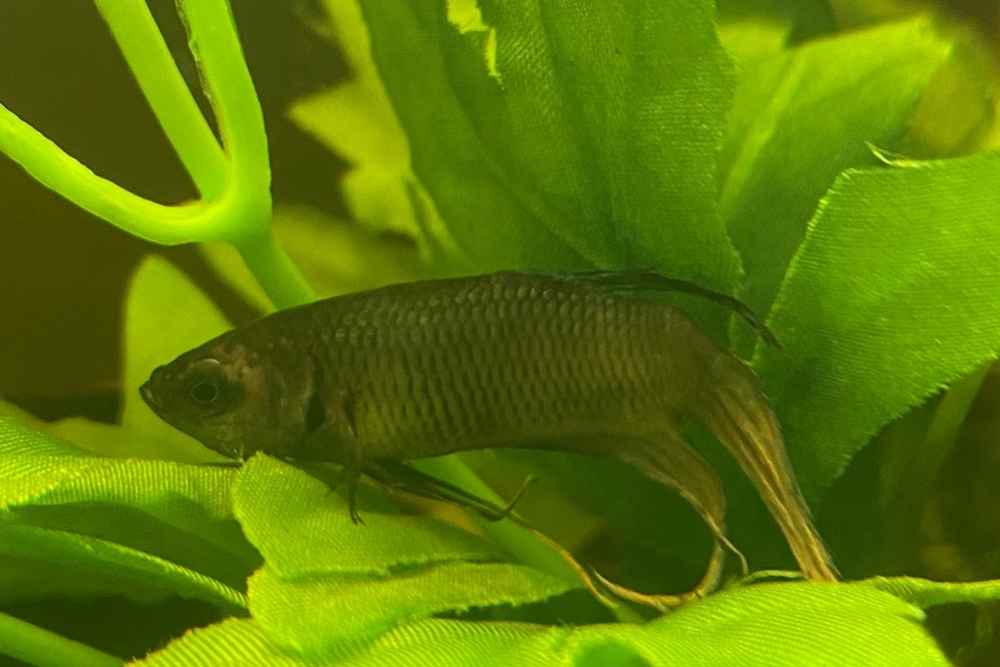
What is Columnaris in FIsh
Columnaris disease, also known as cotton wool disease or saddleback disease, is caused by the gram-negative bacterium Flexibacter columnaris.
This bacteria is present in most aquatic environments and can infect a wide variety of fish species, both freshwater and marine.
It is highly infectious and leads to severe financial and economic losses at fish farms around the world annually.
Usually, young fish are more susceptible to this disease. However, healthy and older fish may act as carriers of the disease.
What Causes Columnaris in Fish
Some of the common causes of columnaris disease include:
Bacterial Infection
Columnaris disease is a bacterial disease that can affect various species of fish. A bacterium that causes columnaris disease (Flexibacter columnaris) is a member of the family Flavobacteriaceae.
This bacteria is found in both salt and fresh water and can cause significant damage to the fish’s skins, fins, and gills.
Flavobacterium columnare, which can cause a wide range of symptoms in fish, including skin lesions and ulcers.
One of the most distinctive symptoms of columnaris is the development of a dark, raised lesion on the back, which can resemble a saddle.
This is why the disease is often referred to as “saddleback disease.” The lesion is typically raised and can be dark in color, brown, grey or black and can be surrounded by a lighter area of skin.
The lesion can also cause the fish to develop a hump-backed appearance, which is another reason for the name “saddleback disease.”
High Water Temperature
Columnaris disease is more likely to occur in warmer water temperatures, as the bacteria thrive in warm and humid conditions.
Outbreaks of F. columnaris infection are most likely to occur at temperatures between 20 and 30°C, although highly virulent strains can cause fish deaths at lower temperatures. Mortalities are less common at temperatures below 15°C.
Low water quality
Poor water quality, such as high levels of ammonia, nitrites, or dissolved organics, can stress fish and make them more susceptible to columnaris infection.
High ammonia levels and low dissolved oxygen also contribute to stress and increase the risk of fish diseases.
Crowding
Overcrowding in fish tanks or ponds can also stress fish, making them more vulnerable to infection. High stocking densities cause high bio-loads and lower oxygen levels in a fish tank, but they also increase the stress levels of the fish.
Trauma
Physical injury to the skin or fins can provide a point of entry for the bacteria to infect the fish.
Stress
The disease is generally associated with environmental stressors that can weaken the fish’s immune system, allowing the bacteria to infect and cause damage to the skin, fins, and gills.
Environmental stressors such as changes in water chemistry, pH or dissolved oxygen levels can weaken the fish immune system and make them more susceptible to columnaris disease.
Co-infections
Fish already infected with other pathogens may have a weakened immune system, which makes them more susceptible to columnaris infection.
Species affected
- Freshwater fish such as:
- Rainbow trout
- Arctic char
- Catfish
- Salmon
- Bass
- Bluegill
- Carp
- Koi
- Tilapia
- Marine fish such as:
- Flounder
- Sole
- Sea bass
- Grouper
- Snapper
- Barramundi
- Eel
- Tuna
3. North American fish such as:
- Channel catfish (Ictalurus punctatus)
- Blue catfish (I. furcatus)
- Largemouth bass (Micropterus salmoides)
- Fathead minnow (Pimephales promelas)
How Does Columnaris Get Inside Your Aquarium or Culture System?
Flexibacter columnaris, the bacteria that causes columnaris disease, is present in most aquatic environments and can be found in water, mud, and on plants.
The bacteria can enter an aquarium in a variety of ways:
Through the water: If the bacteria is present in the source water used to fill the aquarium, it can enter the tank along with the water.
Through new fish: New fish that are introduced to the aquarium may be carrying the bacteria on their skin or fins.
Through equipment: Equipment such as nets, filters, or decorations can also carry the bacteria into the aquarium if they have not been properly cleaned and disinfected.
Through other organisms: Live food or other aquatic organisms that are introduced to the aquarium can also carry the bacteria into the tank.
It’s also worth noting that, once inside an aquarium, the bacteria can survive and multiply in biofilm, which can help them to persist in the tank even if the initial source of infection is removed.
It’s important to practice good hygiene and biosecurity measures, such as quarantining new fish, properly cleaning equipment, and using a good quality water conditioner, to prevent the bacteria from entering and establishing in the aquarium.
Signs and Symptoms of Columnaris Disease in Fish
An acute to chronic infection which affects the gills, fins, and skin of fish. Common symptoms of fish columnaris are,
–The fish may develop a white or gray film over its body and eventually die in severe cases.
-Yellowish areas of necrotic tissue can appear in the gills in the case of adult fish. Accumulation of blood masses causes congestion of gill lamellae. Edema is also noticed in gill lamellae.
In the ventral part of the first gill arch, visible yellowish-white areas of degeneration (indicated by an arrow) can be seen.
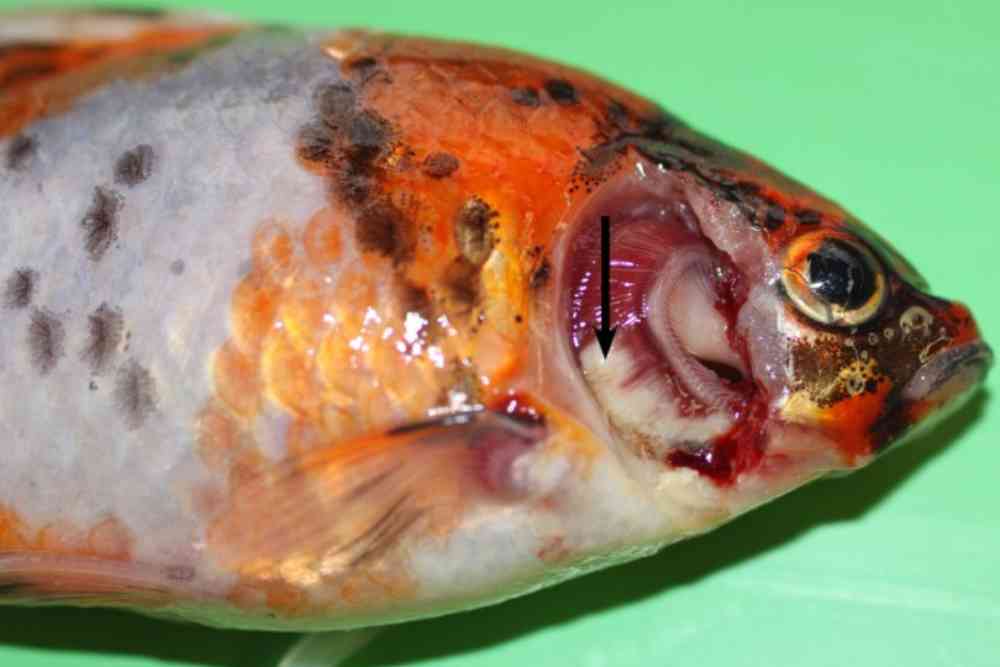
Source: veterinaryresearch.biomedcentral.com
–Small lesions and pale discolored skin with a reddish tinge are visible in the fish. The lesions are covered with yellowish-white mucus and may develop cranially and caudally.
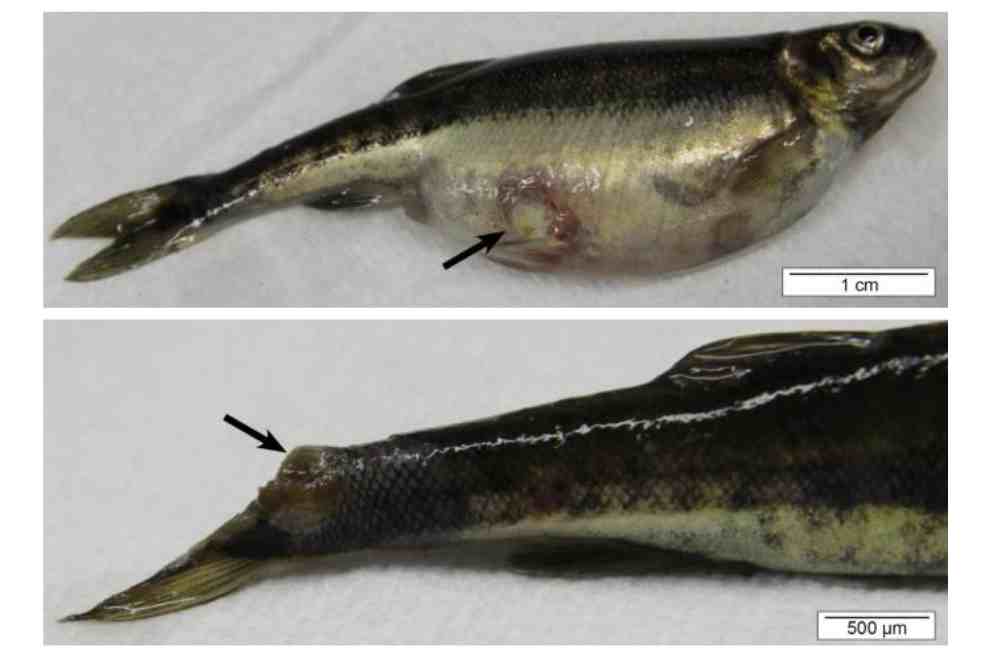
-In a case of columnaris infection, examination of the gill filaments revealed significant erosion and damage. The filaments appeared brown in color and were covered with necrotic debris.
This debris was composed of dead tissue and cellular debris that had been sloughed off from the gill filaments. The erosion of the gill filaments was likely caused by the bacterial infection, which had damaged the delicate tissue and led to the death of cells.
The brown color of the necrotic debris likely indicates the presence of pigments produced by the bacteria or the breakdown of red blood cells which is a common symptom of columnaris infection.
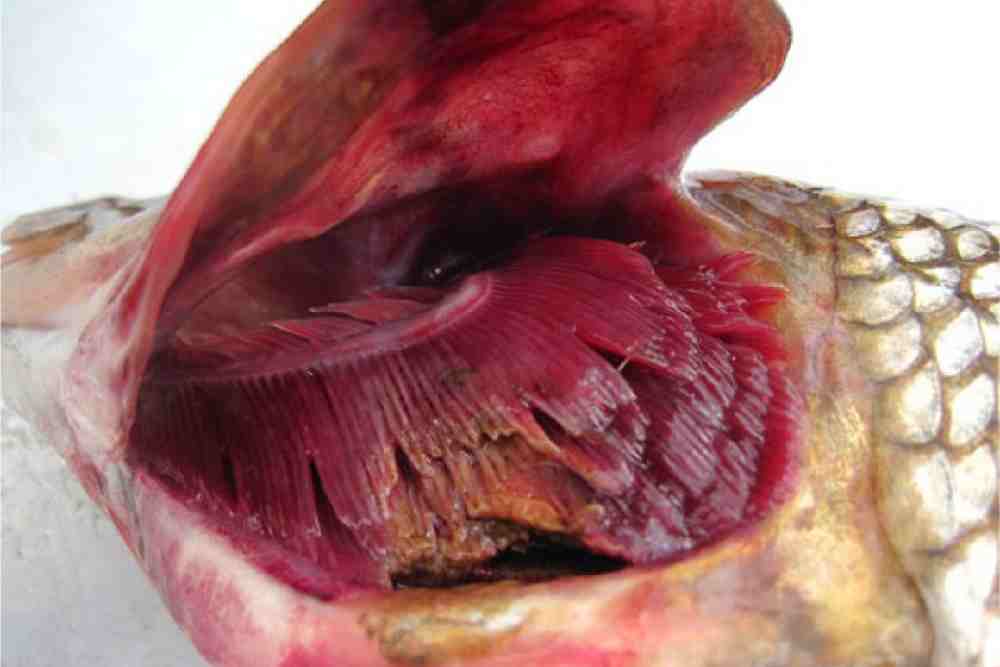
How to Diagnose Columnaris Diseases in FIsh
Sometimes the infection will take an internal course which may not display any external symptoms. Then it becomes so difficult to diagnose the disease.
However, there are a few things to look out for that can help you narrow down the possibilities.
Scanning Electron Microscopy (SEM)
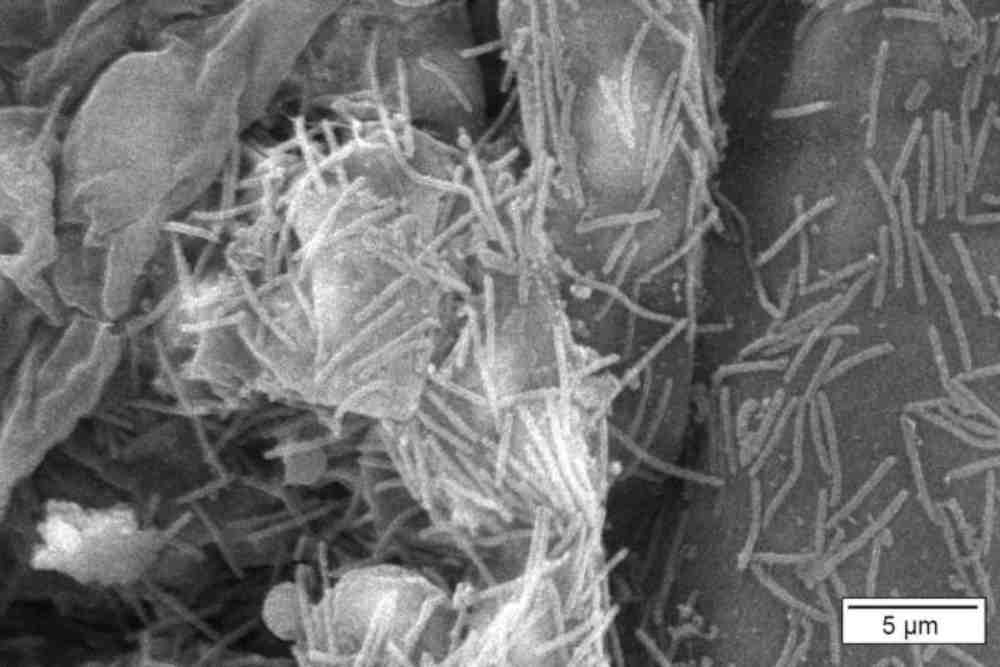
Scanning electron microscopy can be used to detect the shape of bacteria by imaging the surface of a bacterial culture or a sample taken from an infected area.
The resolution of SEM is very high, allowing for the detection of fine details such as the shape of individual bacterial cells.
Scanning electron microscopy (SEM) use a beam of electrons to scan the surface of a specimen.
As the electrons hit the surface, they cause the electrons in the atoms of the specimen to be emitted, creating a signal that is used to create an image of the surface. Then the image is then magnified and displayed on a screen.
Histopathological Observation
During a case of Flavobacterium columnare infection, a gross Histological observation of the gills revealed severe pathological changes. Hemorrhage, characterized by the presence of blood in the tissue, was observed in the primary gill filaments.
Additionally, there was severe congestion, or an excessive accumulation of blood, in the primary gill filaments.
The infection likely resulted in inflammation and damage to the blood vessels in the gill filaments, leading to hemorrhage and congestion.
These symptoms can cause difficulty in oxygen uptake and can be fatal if not treated in time.
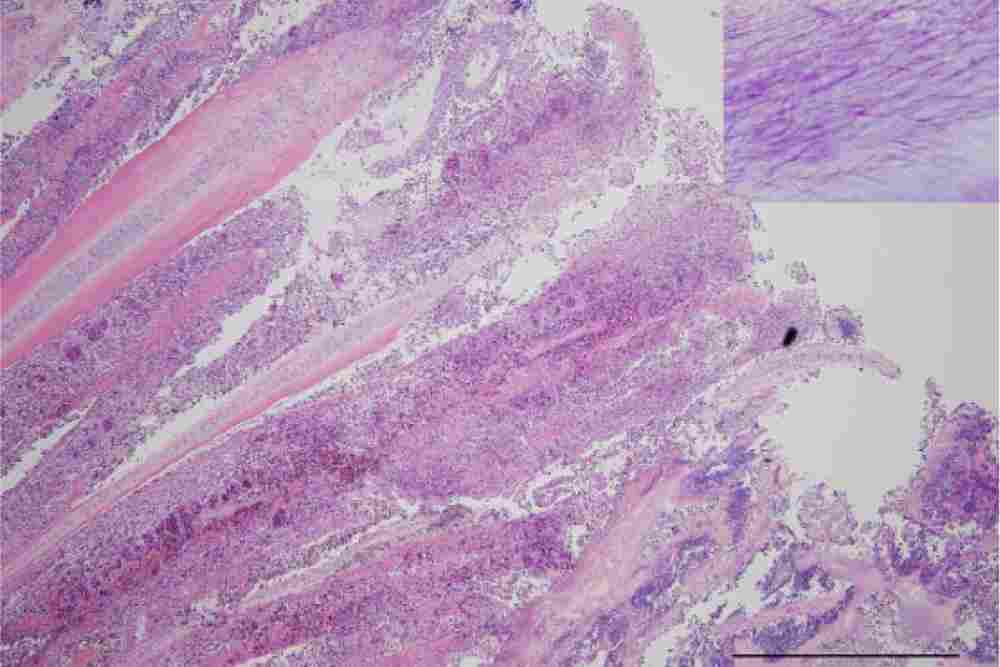
Molecular Test
–Serological methods such as the enzyme-linked immunosorbent assay (ELISA) and fluorescent antibody test efficiently diagnose columnaris.
–Polymerase chain reaction (PCR) has gained interest in differentiating F. columnare based on the selective amplification of 16S rRNA using species-specific primers.
How to Treat Columnaris in Fish
There are several methods of treating columnaris disease in fish. One standard treatment is using antibiotics, such as erythromycin or tetracycline.
These antibiotics can be added to the water or given to the fish orally.
If the disease is advanced and bacteria that cause septicemia are present, antimicrobials need to be provided in the feed.
A combination of antibiotics should work for treating Flavobacterium columnare diseases of fishes.
-Oxytetracycline was given orally for ten days and proven effective in treating the condition in its early stages.
Sulfonamides, such as sulfamerazine and sulfamethazine, can be used orally but are less effective than other medications.
–Another treatment option is using a formaldehyde-based medication. This medication can be added to the water or applied directly to the fish.
If the disease is severe, it may be necessary to euthanize the fish.
-Isolate sick fish from the healthy fish tank as diseased fish act as a vector for transmitting into another fish.
-Potassium permanganate, copper sulfate, and hydrogen peroxidase can be used to treat external infections for adults and fry. KMnO4 is protective in doses of around 2 milligrams per liter.
-Preventing the development or intensification of columnaris disease could be made possible by treating fish in copper sulfate for 20 minutes at 37.0 mg/L (1:30,000) or a concentration of 0.5 mg/L in pond water.
-Dipping the fish one at a time in a metallic solution of one-half gram to 1 gram per 100 milliliters for 1 to 2 minutes was found to be an effective means of preventing worm load.
-Salt may be used to disinfect the tank water and reduce osmotic stress on fish at a dosing of 1 tsp per gallon of water.
-Vaccines can also be used to prevent outbreaks. A bath immunization with a bacteriophage vaccine was shown to protect carp (Cyprinus carpio) against an experimental challenge, but no antibodies were found in sera from immunized fish.
–A study found that low minimal inhibitory concentration values were observed for several antibiotics including chloramphenicol, erythromycin, furazolidone, kanamycin, lincomycin, nalidixic acid, oxytetracycline and streptomycin against columnaris disease.
However, high minimal inhibitory concentration values were found for the antibiotics colistin, sulfamethoxazole and neomycin against columnaris disease.
Prevention of Columnaris Fish Disease
The management process is essential in preventing columnaris infection in fish. Analysis of common production measurements (feed consumption, pond depth, ammonia levels, and stocking events) was used to anticipate and prevent columnaris diseases in ponds.
As reducing fish density can be an effective method of preventing columnaris disease if the water temperature is exceptionally high, scientists researched potential uses of this method.
It is crucial to control the concentration of nitrates and nitrites and organic load so that F. columnare adheres because it is an essential part of wastewater treatment.
Regular water monitoring may be effective for proper water management.
Probiotics could be a promising approach to the prevention of various kinds of bacterial diseases in aquaculture.
Changing 25% aquarium water regularly is a more effective tool for preventing columnaris disease outbreaks.
Maintaining a proper diet and keeping the water clean will help prevent the fish from becoming stressed.
Fish Columnaris in Pond

Columnaris is a common fish disease that can affect both fresh and saltwater fish. In pond fish, columnaris usually affect the dorsal and ventral fins.
Columnaris is a common disease in fish and can be deadly if not treated quickly. Here are some key points to keep in mind when dealing with columnaris:
-Always keep a close eye on your fish, and if they start showing any signs of illness, such as floating fins or a lack of appetite, take them to the vet immediately.
-If you see any frass (excrement) around the fish’s mouth or jawline, it’s time to take action.
Remove all of the water from the tank and add 1 cup of white vinegar per 5 gallons of water.
After 10 minutes have passed, replace half of the water and let the vinegar solution continue to work for an additional 10 minutes.
Columnaris in Aquarium Fish
Columnaris, caused by the bacterium Flavobacterium columnare, can affect a wide variety of fish species in aquariums. Some of the most commonly affected species include:
- goldfish
- koi
- carp
- catfish
- guppies
- bettas
- cichlids
- tetras
- rainbow fish
- gouramis
- plecos
- swordtails
- discus fish
- axolotl
- and other tropical fish species
Columnaris is highly contagious, and the disease can spread quickly among a population of fish tank. It is important to identify and treat the infected fish as soon as possible to prevent the spread of the disease.
FAQs
Can Columnaris go away on its own?
It is unlikely that Columnaris will go away on its own. Once the bacteria infects a fish, it will continue to cause damage to the fish’s skin, fins, and gills. If left untreated, the infection can quickly spread and lead to death of the fish.
Even though the fish’s immune system can help to combat the infection, it is often not enough to completely eliminate the bacteria.
It is important to address the issue with proper treatments as soon as possible, to prevent the spread of the disease to other fish and to minimize the damage to the infected fish.
How long can a fish live with columnaris?
The length of time that a fish can live with columnaris can vary depending on a number of factors, including the virulence of the strain of Flavobacterium columnare causing the infection, the overall health of the fish, and the presence of any other underlying health issues.
In some cases, fish may die within a matter of days after the onset of symptoms, while in others, the disease may progress more slowly and the fish may survive for several weeks.
Can columnaris survive without water?
Flavobacterium columnare, the causative agent of columnaris disease, is a waterborne bacteria that requires water to survive and propagate. It is not known to survive in a dry or extremely arid environment.
The bacteria can survive in water and on moist surfaces, such as fish tanks, filters, and other equipment. The bacteria can survive in the environment for several weeks, depending on the conditions, such as temperature, pH, salinity, and the presence of other microorganisms.
Therefore, it is important to disinfect equipment, tanks, and other surfaces to prevent the spread of the disease.
Is columnaris contagious to humans?
Columnaris, caused by the bacterium Flexibacter columnaris, is a fish disease and it is not contagious to humans. The bacteria that causes columnaris is specific to fish and cannot infect humans.
However, it is important to practice good hygiene when handling fish or water from an infected aquarium, as the bacteria can be spread through contaminated equipment or hands.
It’s also important to not consume infected fish, as the bacteria can cause food poisoning if the fish is not properly cleaned and cooked.
References
- Declercq, A. M., Haesebrouck, F., Van den Broeck, W., Bossier, P., & Decostere, A. (2013). Columnaris disease in fish: a review with emphasis on bacterium-host interactions. Veterinary research, 44(1), 1-17.
- Wakabayashi, H. (1991). Effect of environmental conditions on the infectivity of Flexibacter columnaris to fish. Journal of Fish Diseases, 14(3), 279-290.
- Decostere, A., Haesebrouck, F., & Devriese, L. A. (1998). Characterization of four Flavobacterium columnare (Flexibacter columnaris) strains isolated from tropical fish. Veterinary Microbiology, 62(1), 35-45.
- Shamsudin, M. N., & Plumb, J. A. (1996). Morphological, biochemical, and physiological characterization of Flexibacter columnaris isolates from four species of fish. Journal of Aquatic Animal Health, 8(4), 335-339.
- Declercq, A. M., Haesebrouck, F., Van den Broeck, W., Bossier, P., & Decostere, A. (2013). Columnaris disease in fish: a review with emphasis on bacterium-host interactions. Veterinary research, 44(1), 1-17.
- Scott, S. J., & Bollinger, T. K. (2014). Flavobacterium columnare: an important contributing factor to fish die-offs in southern lakes of Saskatchewan, Canada. Journal of Veterinary Diagnostic Investigation, 26(6), 832-836.
- Tripathi, N. K., Latimer, K. S., Gregory, C. R., Ritchie, B. W., Wooley, R. E., & Walker, R. L. (2005). Development and evaluation of an experimental model of cutaneous columnaris disease in koi Cyprinus carpio. Journal of veterinary diagnostic investigation, 17(1), 45-54.
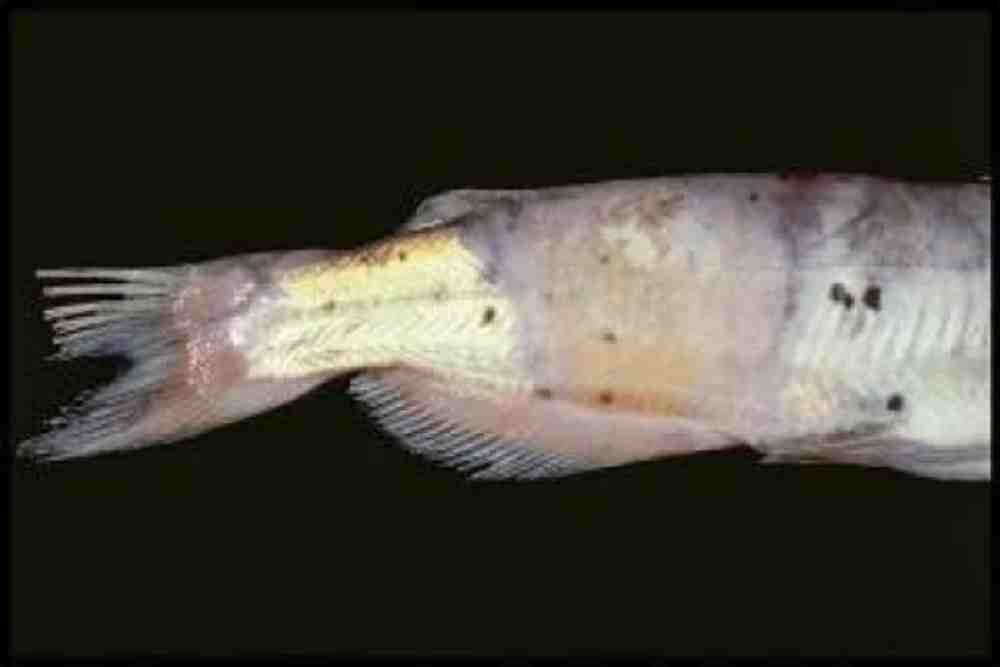

2 thoughts on “Fish Columnaris: Causes, Symptoms & Treatment”
Comments are closed.